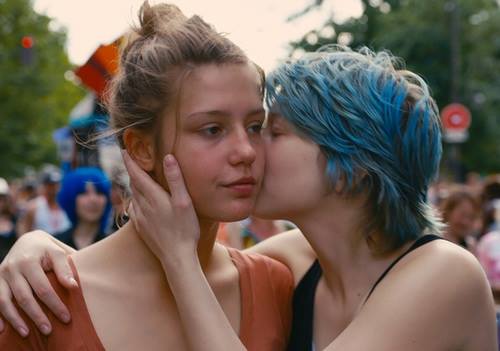The film that launched a thousand reviews and criticisms.
Blue Is the Warmest Color stars Adele Exarchopoulos as Adele, and Lea Seydoux as Emma. Much has been said about this film, both praises and heavy criticisms. Film critics and feminists have attacked and analyzed filmmaker Abdellatif Kechiche’s approach on the intimate scenes between Seydoux and Exarchopoulos. However the film has more to offer than sex. Blue is the Warmest Color focuses on raw emotions, especially that of a young girl who is transitioning into womanhood—yet has some questions—deep questions—about her sexuality and, more importantly, her identity.
The French title of the film is “La vie d’Adèle – Chapitres 1 et 2”, which is an important thing to note because while a good portion of this film is dedicated to Adele and Emma’s love story, it is not primarily about them. This film centers on Adele and her experimentation, struggles, curiosity, appetite, and loneliness. It is centered on her, and sadly, the film opened and closed with Adele in solitude, enduring everything—confusion and misery—on her own, and worse, in silence.
At first her character is established as the young girl with a huge appetite—literally and figuratively. She is your typical teenager, with nice parents, a standard group of friends, and a boyfriend. Things take their turn when Adele comes across Emma for the first time. It was in this scene where we remember what Adele’s teacher had discussed earlier in the film—how does one feel after experiencing first love? Do they feel as though they gained something, or do they feel as though they had lost something? Worse, do they feel any form of regret?

After their paths cross, Adele starts to question her actions and moreover, her identity. She opens up to her friend, “I feel like I’m faking. Faking everything.” Adele soon ends her relationship with Thomas (Jeremie Laheurte) and starts pursuing Emma. The film then carries on from their budding friendship, to their first sexual encounter, and to their breakdown.
Adele and Emma had many differences that might have been a factor in their eventual break-up. Emma, for one, was sure of her identity. She did not need to cling onto anyone to define herself, for she also had a strong sense of philosophy instilled in her. Adele, on the other hand, was young and searching for herself. Then she found Emma and thought she had found something equally as important as her identity in their relationship—her happiness. Which was why when Emma pushed Adele to write, thinking that writing would give her a sense of fulfillment, Adele responded that she did not need to become a writer to be happy. She was already happy the way she was with Emma. This is where perhaps “I Follow Rivers” was the most fitting song to describe how Adele felt for Emma—that she would follow her anywhere, and perhaps when she was singing and dancing along to the song, she only had Emma in mind.
Performances by Exarchopoulos and Seydoux were nothing short of remarkable. They did openly share their struggles in Kechiche’s directing technique, saying that some takes were too intense, to the point where it felt grueling, but no signs of weariness were shown in their acting, except for the scenes that needed it. May I also note that Seydoux has completely transformed from that sweet French girl Owen Wilson eventually ended up with in Midnight in Paris.
The thing with Blue Is the Warmest Color is that it explores the different dimensions of youth, self-discovery, and romantic relationships that are universal despite the same-sex backdrop. It is not afraid to show the angst, social and economic crises, and sexual curiosity that altogether make up this masterful piece of art.
*Blue Is the Warmest Color / La vie d’Adèle – Chapitres 1 et 2 has won Palme d’Or in Cannes 2013
To conclude this review, let me share with you my favorite scene that I sometimes always dance to.